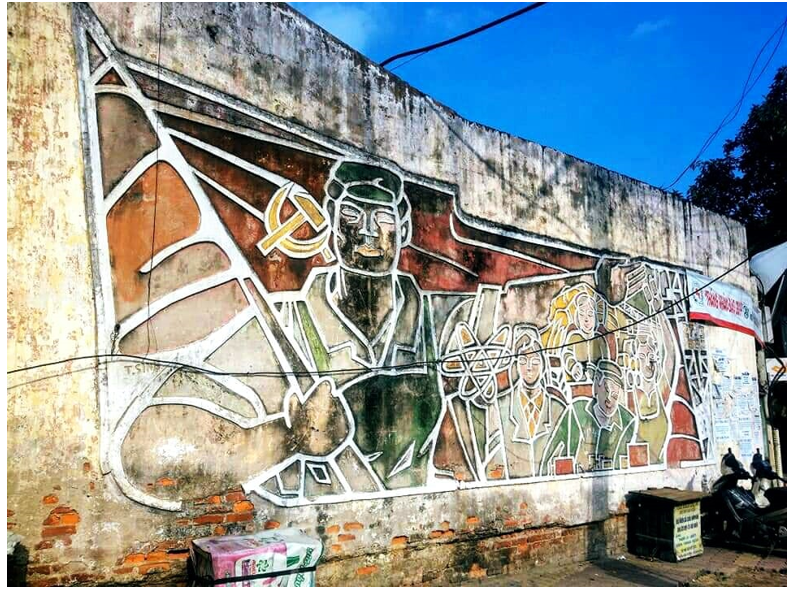Authorities have backed a proposal to relocate the remainder of a nearly-four-decade-old propaganda mural in Hanoi, which had almost been destroyed for site clearance, for preservation.
In March this year, pictures in local media showed parts of the stucco mural had been demolished in site clearance for the construction of a ring road, and many people assumed its fate had been decided.
Back in late 2019, some newspapers reported that the two murals situated on Cho Mo Intersection in Truong Dinh Ward, Hai Ba Trung District, Hanoi were about to be destroyed to make room for the road project.
One ceramic mosaic mural depicts a young woman holding flowers and waving her hands to guests at an old gate in Hanoi.
The artwork was completed in 1981, according to Truong Son, a son of the late artist Truong Sinh who created both artworks.
Son said the other mural is embossed with stucco and features five healthy, youthful individuals to foster the solidarity of the youth in all fields of the post-war society.
Completed in 1982, this artwork suggests the alliance bloc of farmers, workers, and the intelligentsia, and is in the same style of Soviet propaganda art as the other mural.
The two murals are typical of propaganda paintings at that time, when Vietnam had just been reunified after decades of war.
They are a valuable part of Hanoi’s urban heritage during the socialist development stage in Vietnam, according to architect Khuat Tan Hung from Hanoi Architectural University and Hanoi researcher Nguyen Truong Quy.
Quy, another son of the murals’ author, cited the municipal Department of Culture and Sports as saying that the two were not included in a list of the city’s potential historical sites; therefore, the department agreed to his family’s request to relocate them to their own land for preservation.
In February this year, the sons of the late painter relocated the first mural to their piece of land on the outskirts of Hanoi.
However, the family failed to move the other mural due to its size.
The last resort was to cut the whole wall and relocate it as one piece, but they were financially unable to do so and had difficulty finding a place to reconstruct the artwork.
Happy ending
When a part of the stucco mural had bitten the dust over site clearance, Truong Son received text messages in March from Martin Rama, project director at the Center for Sustainable Urban Development under the Hanoi-based Vietnam Academy of Social Sciences.
Rama expressed his intention of helping the family relocate the mural for preservation.
Speaking to Tuoi Tre (Youth) newspaper, the foreign man said he has been keeping a close watch on the fate of the two murals since 2019.
As a lover of Hanoi, he spoke highly of the city’s unique features which are the results of important events over many stages of the country’s history.
As he saw the pictures of the mural being demolished, he felt heartbroken. Without hesitation, he asked his Vietnamese architect friends and the family of the late artist to work together for the sake of preservation.
Rama pledged to provide all the funding for the relocation of the stucco mural.
However, the challenge is to seek a way to re-erect the artwork. Artist Nguyen The Son at the Vietnam University of Fine Arts has found a feasible solution that involves relocating the mural to the sidewalk on Tran Quang Khai Street, near the historical Long Bien Bridge.
Placing the mural there is expected to link the city’s important urban arts spaces, including a public arts project on Phung Hung Street, the artwork of the late artist Truong Sinh, and a so-called ceramic road, part of the Phuc Tan public arts project, according to Son.
As this required approval from the city’s administration, Martin Rama, also the former World Bank chief economist for the Latin American and Caribbean regions, wrote a letter to municipal chairman Nguyen Duc Chung.
Chung gave his support to the proposal in late April.
The nearly-four-decade-old mural is now covered, pending its relocation.
A plan to restore the destroyed section of the artwork is also underway. The sons of the late artist have been invited to be part of the efforts.
Son suggested the restored section should be black and white to differentiate itself from the original one and serve as a reminder of the efforts to preserve the artwork.
Like us on Facebook or follow us on Twitter to get the latest news about Vietnam!


















































